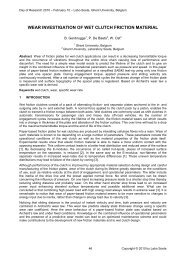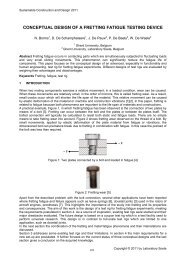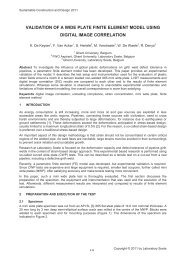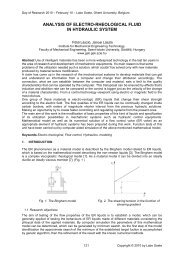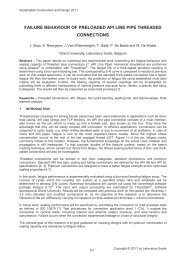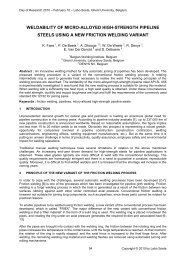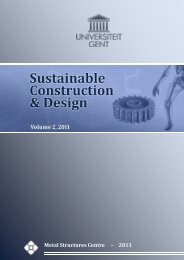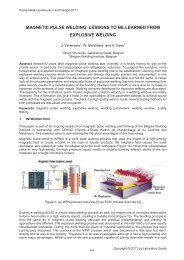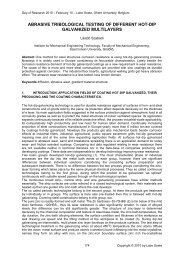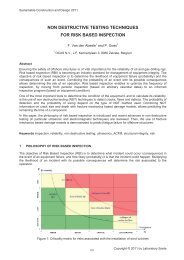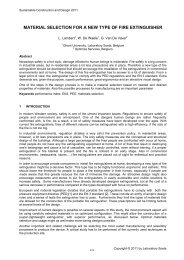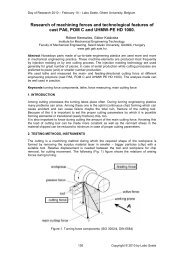F - 5th International Conference on Sustainable Construction and ...
F - 5th International Conference on Sustainable Construction and ...
F - 5th International Conference on Sustainable Construction and ...
You also want an ePaper? Increase the reach of your titles
YUMPU automatically turns print PDFs into web optimized ePapers that Google loves.
Day of Research 2010 – February 10 – Labo Soete, Ghent University, Belgium<br />
Where N is the number of cycles,<br />
eq<br />
is the range of v<strong>on</strong>-Mises stress, R V is the triaxiality functi<strong>on</strong>, m is<br />
the power c<strong>on</strong>stant in Ramberg-Osgood equati<strong>on</strong>, <strong>and</strong> A <strong>and</strong> are damage parameters, which can be<br />
determined experimentally. For given N, m, A <strong>and</strong> , the range of v<strong>on</strong>-Mises stress<br />
eq <strong>and</strong> triaxiality<br />
functi<strong>on</strong> R V can be determined from stress analysis results, <strong>and</strong> therefore D can be calculated using<br />
Equati<strong>on</strong> (15). An example of the evoluti<strong>on</strong> of D in an adhesive layer with fillet used for a scarf joint [18] is<br />
shown in Figure 8.<br />
N = 1<br />
D max = 0.002<br />
N = 15<br />
D max = 0.038<br />
Figure 8. Fatigue damage evoluti<strong>on</strong> in adhesive layer<br />
N = 28<br />
D max = 0.204<br />
In fatigue crack propagati<strong>on</strong> analysis, a crack growth equati<strong>on</strong> (e.g. Paris law) is numerically integrated<br />
within a FE stress analysis. A modified Paris law that includes the threshold <strong>and</strong> accelerating crack growth<br />
regi<strong>on</strong>s is given by [19]:<br />
n<br />
<br />
1<br />
G <br />
<br />
<br />
<br />
<br />
th<br />
da 1<br />
<br />
n Gmax<br />
<br />
DG<br />
<br />
(16)<br />
max <br />
n2<br />
dN<br />
<br />
G <br />
<br />
<br />
<br />
<br />
max<br />
1<br />
<br />
<br />
Gc<br />
<br />
Where da/dN is the crack growth rate, G max is the maximum strain energy release rate at a specific stress<br />
ratio, G th is the fatigue threshold, G c is the fracture toughness, <strong>and</strong> n, n 1 <strong>and</strong> n 2 are c<strong>on</strong>stants. A procedure<br />
that is used to numerically integrate the crack growth law in FE analysis is shown in Figure 9. This<br />
procedure has been implemented in the FE package ANSYS. The applicati<strong>on</strong> of the crack propagati<strong>on</strong><br />
procedure to a single lap joint is shown in Figure 10 [19]. Only half of the joint was modelled with rotati<strong>on</strong>al<br />
symmetric boundary c<strong>on</strong>diti<strong>on</strong>s in the mid-plane. The number of cycles to failure were calculated twice for<br />
each load value; a) using the total strain energy release rate (G max or G T ) <strong>and</strong> b) using the mode I strain<br />
energy release rate (G I ).<br />
Initial c<strong>on</strong>diti<strong>on</strong><br />
a=a o <strong>and</strong> applied<br />
load F=F i<br />
FE stress<br />
analysis,<br />
Crack length=a i<br />
Determine<br />
G max or G I<br />
Small crack<br />
increment<br />
a<br />
Calculate (da/dN)<br />
from equati<strong>on</strong> (16)<br />
Draw F-N f<br />
(load - number<br />
of cycles to<br />
failure) diagram<br />
No<br />
Yes<br />
Another load be<br />
c<strong>on</strong>sidered?<br />
(F i =F i-1 +F)<br />
No<br />
Yes<br />
Has ‘a’ reached<br />
the maximum<br />
allowable crack<br />
length (a f )?<br />
Figure 9. Fatigue crack propagati<strong>on</strong> procedure<br />
Calculate new<br />
‘N’ <strong>and</strong> ‘a’ as:<br />
N i+1 =N i +N<br />
a i+1 =a i +a<br />
Calculate N i<br />
as:<br />
N i =a i /(da/dN)<br />
Figure 10. Fatigue crack propagati<strong>on</strong> in a single lap joint<br />
36 Copyright © 2010 by Labo Soete



